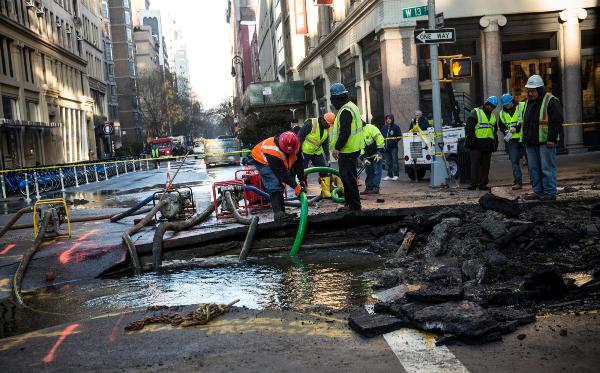The City Must Step Up on Sandy Business Recovery

(visitstatenisland.com)
The following entry is part of The Small Business Corner, a collaboration between Gotham Gazette and GoBizNYC:
At a recent a press conference on the City's Sandy recovery progress, Mayor Bill de Blasio noted: "Relief can't come fast enough for homeowners and small business owners who have already waited too long." We cannot agree more. Twenty-one months after the storm, so much more remains to be done. The City needs to expedite programs, provide grants—even retroactively—and implement a better approach to resiliency planning in neighborhoods ravished by Sandy.
Revamping the "Build It Back" program is essential and has been a step in the right direction. Recently, NYC Housing Recovery reached out to our organization, the Staten Island Chamber of Commerce, for assistance in bringing local contractors to the table to learn how they can provide services through the program. In addition, the City is improving the onerous procurement process for contractors so that they will get paid for their services in a timely fashion. This is encouraging.
That being said, the City needs to better coordinate with Federal and State agencies and comprehensively address the difficulties businesses have had when dealing with various layers of government.
For instance, the business recovery process needs to be streamlined so that allocated Community Block Development Grant (CBDG) funds actually get into the hands of businesses, which have struggled to recover on their own for almost two years. It is a real disgrace that of the $293 million dollars allocated for business recovery in New York City (as of April 1, 2014), only $3.5 million has been distributed to businesses. Bureaucratic bottlenecks must be resolved. In addition, an inventory needs to be done to assess how many impacted businesses did not come back or are teetering to stay afloat as well as where vacancies lie and opportunities exist.
Given that small businesses are the backbone of our economy, adjusting bureaucracy to meet the realities of small business capacity and accelerate business recovery should be a top priority for this administration. Such efforts will only make our local economy more resilient to future disasters.
The Staten Island community, through its strength, determination, and pride, has taken up the task of bringing back our neighborhood economies, one business at a time. But we can't do this on our own. We need this administration to step up with us and take a holistic approach to rebuilding and resiliency planning – not only on Staten Island, but in all of New York City.
Linda M. Baran is the President of the Staten Island Chamber of Commerce, the largest business organization on Staten Island. The Chamber is comprised of over 700 businesses, 80% of which are small businesses with fewer than ten employees.
@SIChamber
***
@GoBizNYC
@GothamGazette
To make or discuss a submission for The Small Business Corner:
Reach GoBizNYC Director Victor Wong at This email address is being protected from spambots. You need JavaScript enabled to view it.
Reach Gotham Gazette Executive Editor Ben Max at This email address is being protected from spambots. You need JavaScript enabled to view it.
The Small Business Corner is a bi-weekly column featuring the opinions and perspectives of small business owners and advocates from the GoBizNYC network on the range of issues that concern the city's small businesses.
To all New York City small business owners and advocates: we hope this new platform, The Small Business Corner, will better enable you to engage in the local policy conversation and we look to you to support us in this endeavor by sharing your thoughts, experiences, and voices. To learn more about how you can be a part of GoBizNYC and participate in this effort, visit GoBizNYC.org.
Desperately Needed Infrastructure Improvements Must Be Given Dedicated Funding

A water main break in Manhattan (photo: Laura Shin)
Earlier this month, BNP Paribas plead guilty to money laundering and falsifying business records. The French Bank will pay $8.9 billion in fines, with approximately $4 billion directed to New York State and its municipalities. As politicians and civic leaders rushed to offer recommendations for directing this windfall, a consensus began to emerge: the construction, rehabilitation and maintenance of New York State infrastructure.
While the recent settlement is a significant sum, even if it is wholly applied, it will not be enough to address New York's aging and outmoded infrastructure. In New York City alone, thirty-seven percent of subway signals exceed their 50-year useful life; 63 percent of cargo facilities at John F. Kennedy airport are considered "non-viable" for modern screening; 24 percent of the water that enters distribution mains never reaches customers due to leaks and other diversions; 11 percent of bridges are structurally deficient; and nearly 60 percent of NYCHA buildings do not comply with Local Law 11 standards for exterior and façade conditions.
The Center for an Urban Future estimated that $47 billion is needed over the next four to five years simply to bring the city's aging infrastructure to a state of good repair. However, based on accumulated funding gaps and shortfalls in upcoming capital plans, unmet needs will reach $34.2 billion. To address this large and growing funding gap, it's imperative that city and state policymakers identify new dedicated revenue streams and ensure that existing revenue streams are not raided, as they have too often been in the past.
Sam Schwartz's "Fair Plan," for instance, would introduce new tolls on those East River bridges carrying vehicles into the city's central business district while sharply reducing tolls on five non-Manhattan bridges. Most importantly, the dedicated revenue from Schwartz's plan would generate $1.2 billion annually for transit projects and regional highway improvements.
For an additional dedicated funding stream, New York City should follow Seattle, Philadelphia, and 500 other cities in replacing its sewer charges - currently assessed at 159% of the water rate - with a more nuanced stormwater management fee. Property owners would be charged according to the percentage of rainwater captured on their lots (before it enters the city's overburdened sewer system). This would incentivize increased water retention on private property, with customers paying a lower fee as they introduce new green elements – trees, swales, porous pavement, green roofs. This could be coupled with a credit program to help customers finance the installation of green elements, with loans repaid each month via a utility or property bill.
Finally, while the BNP Paribas fine is often described as a "one shot deal", it too could be converted into a continuous, dedicating funding source. By depositing the $4 billion into an infrastructure trust fund, it could generate $200 million a year in perpetuity, assuming a conservative 5 percent annual return (the MTA, by comparison, assumes a 7 percent annual return on its pension investments). This $200 million is hardly pittance. In New York City, it would afford 800 new units of low-income housing, the resurfacing of 1,300 lane-miles of city streets, or 34 miles of reconstructed sewers each year.
Moving forward, political wrangling and posturing over court settlements – like the protracted dispute between Governor Cuomo and Attorney General Schneiderman over control of an earlier $613 million settlement with JPMorgan Chase – could be avoided if the state Legislature mandates that a fixed share of future court settlements be deposited into the infrastructure trust. This would help stabilize the state's critical infrastructure for years to come.
As the city and state consider these new funding streams, political officials should refrain from diverting or dipping into existing (and already insufficient) dedicated revenue sources - a practice that has been all-too-common in recent years. At the MTA, $30 million from the Metropolitan Mass Transportation Operating Assistance account was transferred to the state's General Debt Service Fund in 2014. Funds from the Dedicated Highway and Bridge Trust Fund have also been used to cover state budget expenses. In New York City, revenue dedicated to the water and sewage system is redirected to the city's expense budget through "rental payments." Since 2005, these rental payments have increased significantly, from $109 million to $183 million.
The city's airports have also been affected by political interference. While the airports generate significant revenues from landing fees, gate fees and other levies, $214 million at JFK was diverted to non-airport related activities between 2004 and 2010. Though federal regulations require airport operators to reinvest all airport revenue into their facilities, the Port Authority was granted an exemption. In several instances, area politicians have pushed the Port Authority to use funds generated by the airports to prevent toll and fare increases at other Port Authority-managed assets, such as the PATH train.
The protection of these dedicated revenue streams, as well as the introduction of new funding sources, should not be delayed. Without immediate, sustained, and generous investment in its core infrastructure, New York's quality of life and economic competitiveness will quickly diminish.
***
Adam Forman is research associate at the Center for an Urban Future, a New York City based think tank. He is the author of "Caution Ahead," a report published in March by the Center documenting New York's infrastructure vulnerabilities.
***
@GothamGazette
Do you have an op-ed idea or submission for Gotham Gazette? Send it to Executive Editor Ben Max: This email address is being protected from spambots. You need JavaScript enabled to view it.
The Small Business Corner, with GoBizNYC

City of opportunity - and challenges
Small businesses are the backbone of our local economy. They define the character of our neighborhoods and exemplify the entrepreneurial spirit of both new and native New Yorkers. Often, they are where young people get their first work experience and where seniors find a job that helps them make ends meet in their retirement years.
Mayor de Blasio demonstrated his concern for small business earlier this month, when the Department of Consumer Affairs made good on his campaign commitment to reduce fines and begin to reform city inspection processes. That is a good start, but much more remains to be done.
City and state government regularly add to regulatory and legal mandates that fall most heavily on the city's more than 179,000 businesses with fewer than 20 employees. Rhetorical support for small business too often does not translate into public policies that promote their sustainability.
One reason for this disconnect is that the small business community has not fully been a part of the citywide policy conversation. GoBizNYC, a small business initiative of the Partnership for New York City, aims to change that.
GoBizNYC was launched a year ago to elevate the small business voice and, in that time, we have built a network that reaches over 25,000 small businesses across the five boroughs. Our mission is to strengthen the voice of small, immigrant, and minority-owned businesses, and to create an environment where small businesses can create more jobs and build our city's neighborhood economies.
By working collaboratively with small business groups across the city, including the Five Boro Chamber Alliance, local development corporations, merchant associations, business improvement districts, industry associations, and community-based organizations, we help support the small business community by ensuring that small business concerns are heard and thoughtfully considered by local policymakers.
As part of our effort to amplify the voice of the New York City small business community, we are collaborating with Gotham Gazette to publish the "Small Business Corner," a bi-weekly column featuring the opinions and perspectives of small business owners and advocates from the GoBizNYC network on the range of issues that concern the city's small businesses.
These op-eds will address policies that impact a small business directly, such as government efficiency and regulations, while also considering issues that affect a small business' ability to survive and thrive in New York City, such as infrastructure, public safety, education, and livability. This effort also exemplifies Gotham Gazette's commitment to bringing a wide range of voices and issues into the civic discourse through both its original reporting and its op-ed pages.
To all New York City small business owners and advocates: we hope this new platform will better enable you to engage in the local policy conversation and we look to you to support us in this endeavor by sharing your thoughts, experiences, and voices. To learn more about how you can be a part of GoBizNYC and participate in this effort, visit GoBizNYC.org.
***
Victor Wong is the Director of Business Outreach & GoBizNYC at the Partnership for New York City
Reach Victor Wong at This email address is being protected from spambots. You need JavaScript enabled to view it.
Reach Gotham Gazette Executive Editor Ben Max at This email address is being protected from spambots. You need JavaScript enabled to view it.





